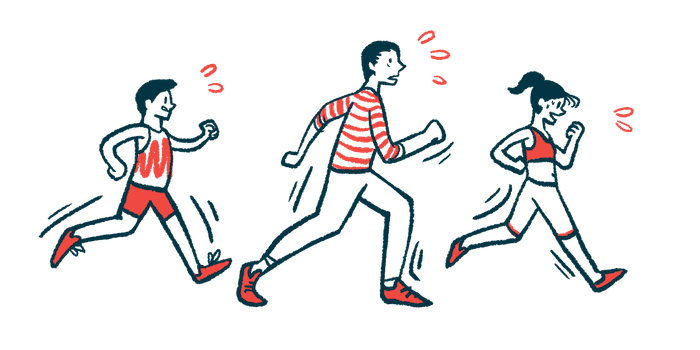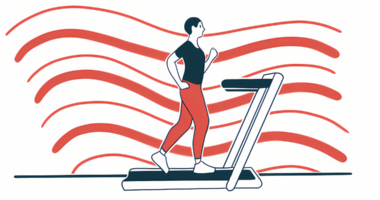Study: Some types of MS pain make exercise more difficult
Researchers surveyed 938 patients about three different types of pain

Chronic pain can make it harder for people with multiple sclerosis (MS) to be physically active, but some types of pain have a bigger effect than others, a study suggests.
The findings show not just whether a patient is having chronic pain needs to be considered, but also what kind of pain, so personalized exercise programs can be developed.
“There is a growing need to consider what type of pain MS patients are experiencing before giving them an exercise plan,” Libak Abou, PhD, a professor at the University of Michigan and co-author of the study, said in a news release.
The study, “Widespread Pain With Nociplastic Features is an Independent Predictor of Low Physical Activity in People with Multiple Sclerosis,” was published in The Journal of Pain.
Getting regular physical exercise is an important part of staying healthy and the benefits of regular exercise for people with MS are well established. They are more than two times less likely to engage in sufficient levels of exercise compared with healthy people, however.
Three types of pain in MS
Chronic pain, a common symptom of MS, can make it difficult to be physically active. In this study, researchers examined whether different types of pain have different effects on physical activity.
“To date, no study has examined the association between pain phenotype and physical activity in MS. … Therefore, this study addressed the question of whether pain phenotype is a useful indicator of whether or not [people with] MS are participating in a sufficient level of physical activity,” wrote the researchers, who focused on three types of pain as defined by the International Association for the Study of Pain.
The first type is nociceptive pain, which occurs due to tissue damage, like getting a cut or stubbing a toe, that activates pain receptors outside the brain. In MS, muscle spasms are a common cause of chronic nociceptive pain.
The second type of pain is neuropathic pain, which occurs due to damage in nerve cells responsible for sensing pain, which may manifest in sensations like burning or pins and needles. The damage to the brain and spinal cord that happens in MS can cause neuropathic pain.
The third type is called nociplastic pain, also called widespread pain with nociplastic features (WPNF). This arises due to dysfunction in the brain circuits that process the sensation of pain.
WPNF is closely linked with other “invisible” MS symptoms like fatigue and depression, and it’s thought that these symptoms likely arise due to interrelated dysfunction in the brain.
“WPNF is a chronic and diffuse pain, which can be challenging to localize or describe precisely,” Abou said.
The researchers surveyed 938 people with self-reported MS to know more about how each pain type affected them. About three-quarters of the patients were female, more than 90% were white, and the average age was in the early 50s.
The patients completed a battery of standardized questionnaires and, based on the responses, the researchers determined that 6.4% of them didn’t report chronic pain. The most common type of chronic pain was nociceptive, reported by nearly half (42.2%) of them.
More than one in five (21.7%) reported both neuropathic pain and WPNF, which the researchers termed “mixed” pain. Another 9.2% reported only neuropathic pain, while 20.5% had only WPNF.
How much physical activity are patients getting?
Questions about physical activity were also answered, which the researchers used to estimate whether each patient was getting the recommended amount of exercise. More than half (61.8%) were insufficiently active, noted the researchers, who found in statistical models that patients with no chronic pain were more than twice as likely to get the recommended amount of physical activity compared with patients with mixed pain.
Patients with nociceptive pain or with only neuropathic pain also were significantly more likely to get regular exercise than those with mixed pain. There wasn’t a significant difference in physical activity between those with mixed pain and those with WPNF only.
Compared with those with only nociceptive or neuropathic pain, those with WPNF tended to report less physical activity, but the differences weren’t statistically significant.
A statistically significant correlation was shown between WPNF severity and physical activity scores, meaning patients with more severe WPNF were less likely to be active. In fact, for every 1 point increase in scores on the ACR FM survey, which was used to determine which patients had WPNF, patients were 7% less likely to get enough exercise.
“Individuals with a higher indication of nociplastic pain were more likely to be insufficiently active or sedentary when compared to individuals with no chronic pain, nociceptive pain, or neuropathic pain,” the researchers said. “This highlights the importance of determining specific pain phenotypes to maximize treatment options when the goal is to help [people with] MS achieve recommended levels of physical activity.”
“The concept of considering WPNF when creating exercise plans for MS … could help many patients get to an activity level that will help ease symptoms without causing them intense pain,” Abou said.







